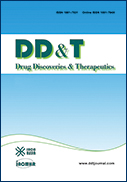Volume 5, Issue 5
Displaying 1-6 of 6 articles from this issue
- |<
- <
- 1
- >
- >|
Reviews
-
2011 Volume 5 Issue 5 Pages 202-210
Published: October 31, 2011
Released on J-STAGE: February 15, 2015
Download PDF (503K)
Original Articles
-
2011 Volume 5 Issue 5 Pages 220-226
Published: October 31, 2011
Released on J-STAGE: February 15, 2015
Download PDF (355K) -
2011 Volume 5 Issue 5 Pages 227-237
Published: October 31, 2011
Released on J-STAGE: February 15, 2015
Download PDF (198K) -
2011 Volume 5 Issue 5 Pages 238-245
Published: October 31, 2011
Released on J-STAGE: February 15, 2015
Download PDF (231K) -
2011 Volume 5 Issue 5 Pages 246-252
Published: October 31, 2011
Released on J-STAGE: February 15, 2015
Download PDF (173K) -
2011 Volume 5 Issue 5 Pages 253-260
Published: October 31, 2011
Released on J-STAGE: February 15, 2015
Download PDF (216K)
- |<
- <
- 1
- >
- >|
